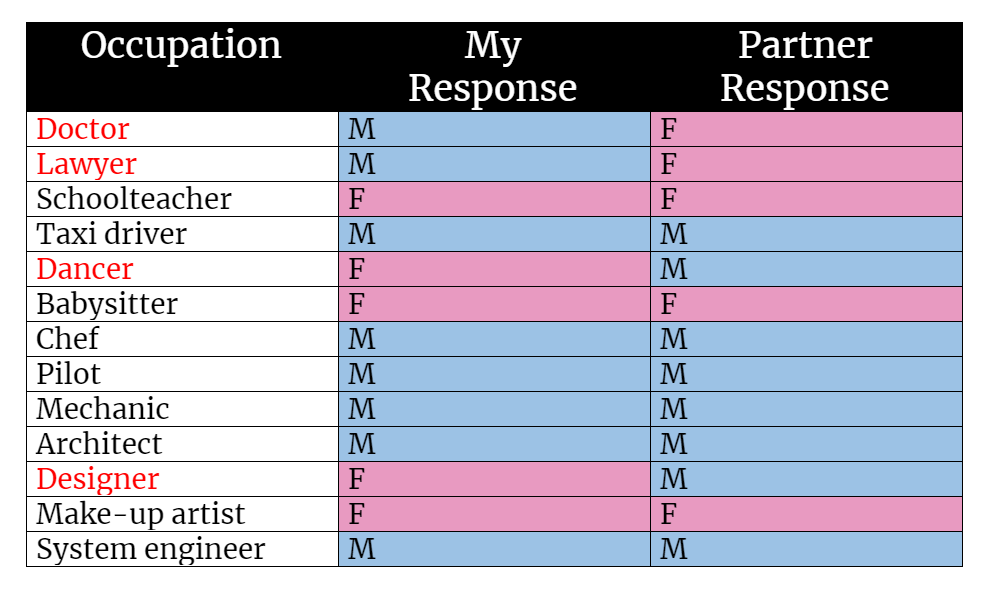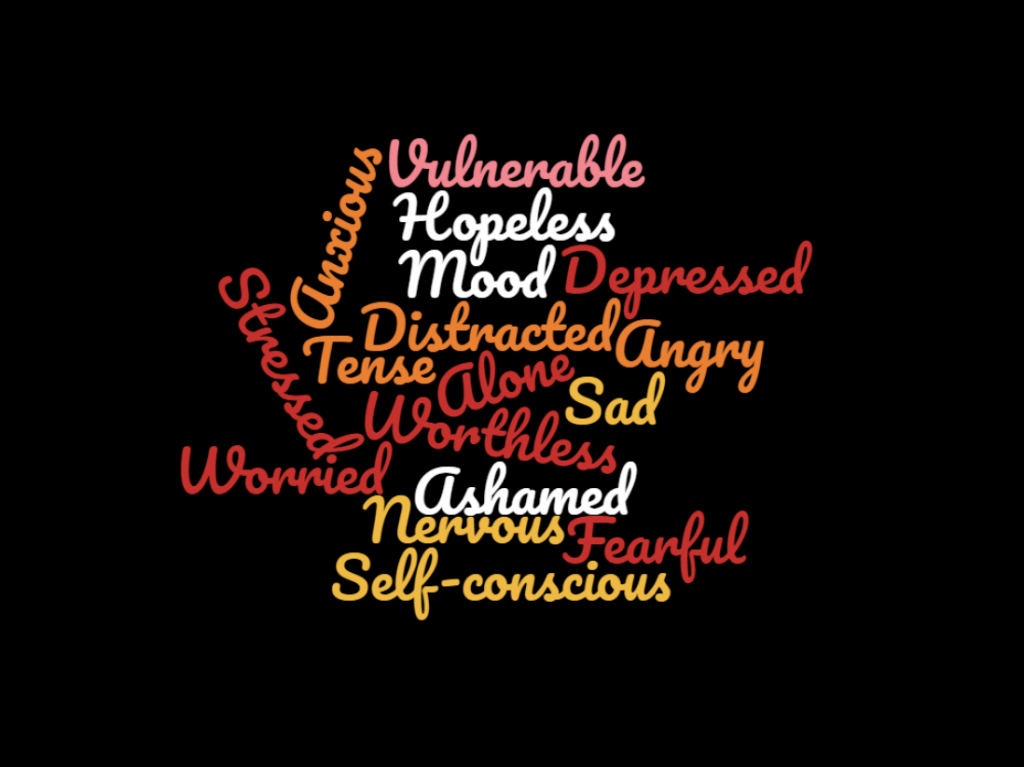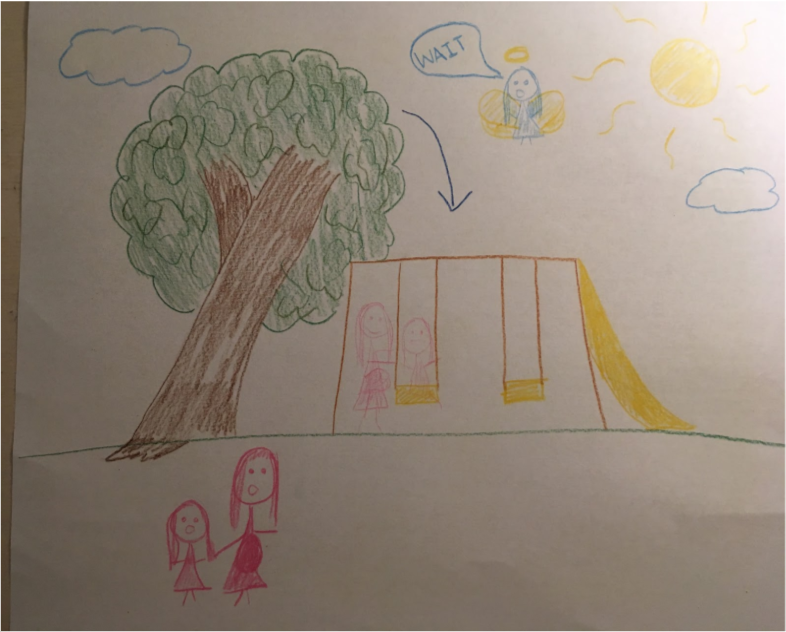My top 5 favorite artifacts, with #1 as my favorite
#5: Module 9 – Gender Bias

This artifact was intriguing because it demonstrated the effect of gender biases. My partner was a different culture and gender than me. After completing a survey of which gender would most likely hold a certain occupation, we found that we both had the same answers for 9/13 of the items. I answered based on my initial mental image of the occupation and instructed my partner to do the same. An interesting observation from this survey is that I, a female, imaged that higher-paying jobs such as doctor and lawyer to be male-dominated, while my partner categorized these occupations as female-dominated. Overall, my partner and I agreed on many of the genders for each occupation, indicating that bias is present. This assignment shows how significant gender biases are in society today, regardless of gender or culture.
#4: Module 8 – Contradicting Traits

This artifact was interesting because I was focusing on my behaviors that contradicted my personality traits. As discussed in Blog 3, I have a low score in the Neuroticism category. Although that may be true of my personality, there are times in which I can act anxious, angry, depressed, which clash with my personality and are sub-traits of neuroticism. I used the example of taking the GRE for the first time. I felt anxious because of the lack of time I had to study and developed strong testing anxiety. I could hardly read, focus on the questions, and I ran out of time. After I took my GRE for the first time and did not score high enough, I acted depressed. I remember driving home for 40 minutes, exhausted from the four-hour exam, crawling into my bed, and napping. These behaviors do not reflect my high-energy, optimistic personality. I learned that though we are likely to reflect our personality traits, context can impact these traits. When I was put into an environment in which I had to perform under pressure with the GRE, my actions clashed with my personality because I was under stress. This artifact helped me realize that personality traits do not always determine every behavior or emotion.
#3: Module 6 – Traits from a Miracle

I liked this artifact because I was able to tell a story from my childhood and relate it to my personality traits. When I was less than three years old, my mom was pregnant with my sister. It was my dad’s birthday, Mother’s Day, and a beautiful sunny spring day. I wanted to play outside on my brand new swing set. My mom agreed, but she heard a voice that said, “WAIT.” She didn’t know why we should wait, but she decided to wait 15 minutes before she took me outside to play. About 10 minutes later, a big tree fell on the brand new swing set, crushing where my pregnant mother could have been pushing me on the swing. Since that day, my mom has sworn it must have been a guardian angel that told her to wait. I remember parts of this event, and I know it would have been tragic for my dad to come home to find that we were outside during this unexpected event. This story is one that has been retold and interpreted for meaning since it occurred.
I learned how to make connections between a story from my past and my personality traits such as my low neuroticism, or ability to relax in stressful situations, and my high agreeableness, specifically my compassion and thoughtfulness. Some things are out of our control, such as forces of nature, and it is best to accept that everything will happen for a reason. From this experience, my family has grown to appreciate and love each other more, which then made me the good-natured person that I am. I believe that there is good in the world, like miracles, and I know not to take any day for granted. You can never know when a tree will fall on you.
#2: Module 13 – Mind and Body

I enjoyed this artifact because it was a reflection of an idea that is important to me academically and personally. Reflecting on what specifically makes me happy was somewhat difficult for me because I am overall a genuinely happy person. I determined that the relationships I have with others and my experiences make me happy. The people I care about support me and love to watch me grow. Happiness and physical health are intertwined in both ways. When you are happy, you are able to take better care of yourself, thus making you healthier. You are full of energy, active, motivated, and care about yourself. In turn, this physical health leads to more happiness. When you are healthy, you are happier. This is a cyclic pattern. Without one, the other could not exist. The mind and body are connected, and each one is just as important as the other.
#1: Module 7 – Social Engagement

I liked this artifact the most because it gave insight into my self-construal and emotions. By listing five happy memories, I was able to analyze the frequency that my emotions are socially engaged or disengaged. This activity taught me that I have both socially disengaged and engaged emotions. Scoring high enough on the GRE to apply to graduate school was a socially disengaged emotion because it is associated with my own hard work and independence. I was proud of what I was able to accomplish on my own. Visiting my friend who moved to Florida after not seeing her for a year was also a socially disengaged emotion because I gained a sense of independence by traveling by myself for the first time. My final three experiences were examples of socially engaged emotions. Being surprised by my mom and sister when they got me a puppy was an emotion of happiness that was associated with adding a new pet member to the family. I gained a sense of happiness that was dependent on the support of my family and their happiness. Leading a backpacking trip for my job as an Outdoor Adventure Trip leader for ODU is associated with emotions of belongingness to a community including co-leaders and participants. Finally, exploring Dublin with friends I met in my study abroad course last spring break aroused emotions of community-belongingness as well. Exploring a foreign country with people that you can depend on and trust enhanced my confidence in working with this group. Overall, I have found that I am supported by others, but I also have the capability to be independent, and therefore, I have a good mix of socially engaged and disengaged emotions.
